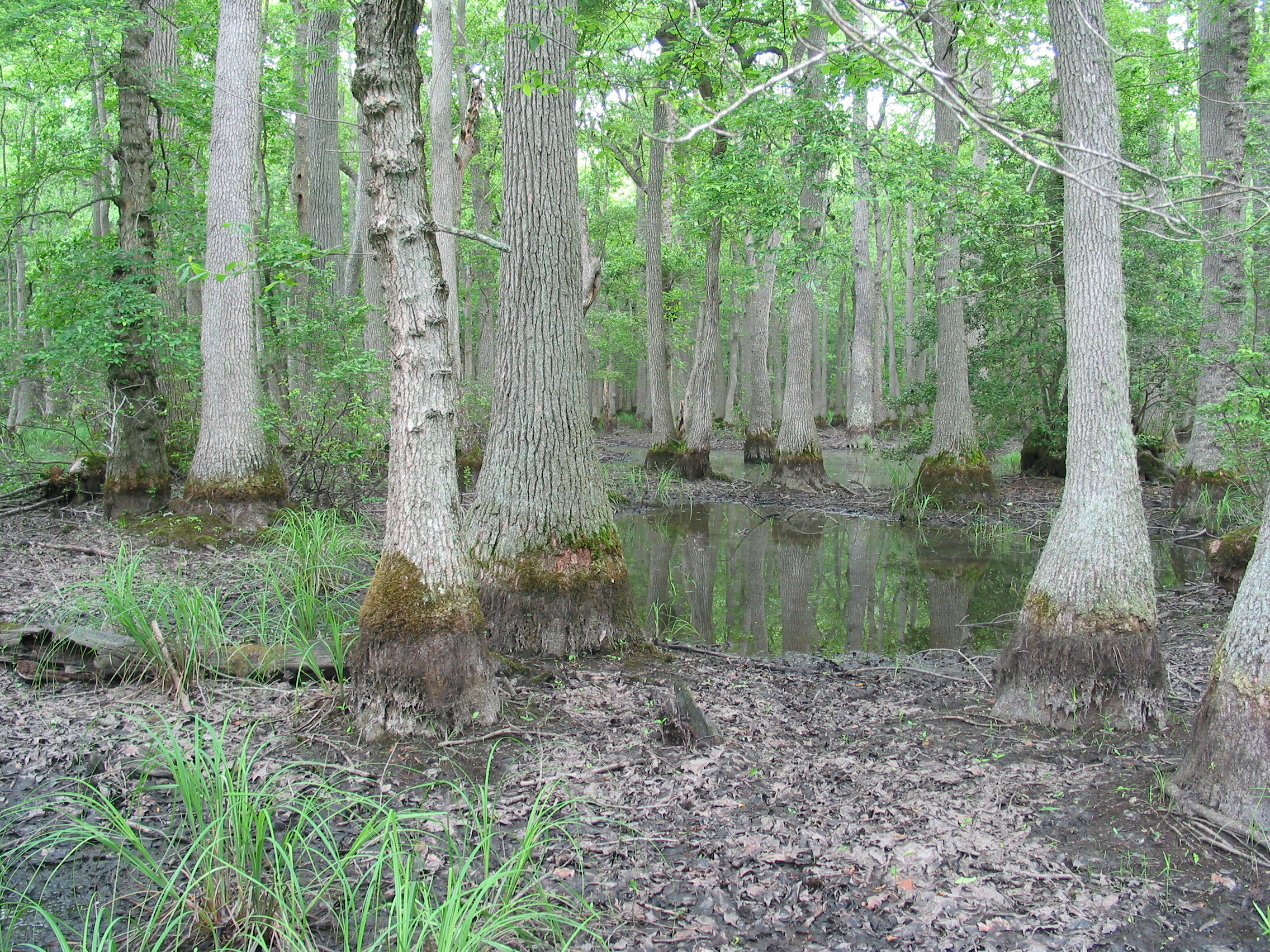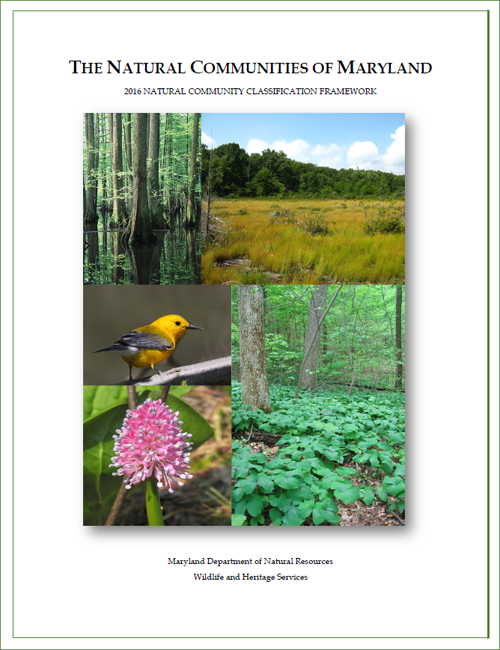 Natural communities are best described as “recurring assemblages of plants and animals found in particular physical environments”. The Maryland landscape is a diverse and complex one with a variety of natural communities represented, from beaches and fringing tidal marshes along the coast to high-elevation peatlands and ravines of old-growth hemlock in the mountains. Each of these natural communities are uniquely tied to a suite of environmental conditions and species adapted to those conditions. Just as a tidal marsh is characterized by species adapted to freshwater or brackish tidal conditions, a montane peatland contains species restricted to higher elevations and cooler climates. Together, they form an intricate network of habitats supporting all of Maryland’s natural diversity that includes more than 16,000 species.
Natural communities are best described as “recurring assemblages of plants and animals found in particular physical environments”. The Maryland landscape is a diverse and complex one with a variety of natural communities represented, from beaches and fringing tidal marshes along the coast to high-elevation peatlands and ravines of old-growth hemlock in the mountains. Each of these natural communities are uniquely tied to a suite of environmental conditions and species adapted to those conditions. Just as a tidal marsh is characterized by species adapted to freshwater or brackish tidal conditions, a montane peatland contains species restricted to higher elevations and cooler climates. Together, they form an intricate network of habitats supporting all of Maryland’s natural diversity that includes more than 16,000 species.
The conservation of Maryland’s natural communities is vital in sustaining our natural diversity and is a priority of the Maryland Natural Heritage Program (MD NHP). Natural communities function as “coarse filters” because their protection benefits all species and processes. According to a national study, habitat degradation and destruction in the is the number one threat to over 85% of our nation’s 1,880 most imperiled plant and animal species (Wilcove and Rothstein et al. 2000). Since 1979, MD NHP has worked on public lands and with private landowners in an effort to identify and protect natural communities through inventory work and natural community studies. This work has yielded much in the understanding of our natural communities especially in determining which ones are rare and in need of conservation. The purpose of this page is to provide access to that information describing the full array of Maryland’s natural communities to those in education, scientific research, environmental consulting, land management, and conservation planning.
 Natural Community Classification
Natural Community Classification
Natural community classification is an important tool that provides a way for biologists to sort, understand, and communicate the complexity of our landscape. Over the years, Maryland Natural Heritage Program (MD NHP) has worked to develop a natural community classification that allows us to:
- compare natural areas to one another,
- understand how rare or common a natural community might be,
- identify and map significant natural resources,
- establish conservation priorities and
- apply effective management strategies.
It is a fine-scaled classification system that uses an ecologically based hierarchy of grouping levels to organize community types in a logical manner. It is conceptually based on similar classifications developed by the MD NHP (Berdine 1999), Virginia Natural Heritage Program (Fleming et al. 2016), and North Carolina Heritage Program (Schafale 2012), and is compatible with the United States National Vegetation Classification (USNVC). An overview of the full natural community classification hierarchy of 79 ecological community groups and 224 community types is provided in “ The Natural Communities of Maryland: 2016 Natural Community Classification Framework”. This document is current as of May 2016 however, future updates are necessary as new information is obtained. More detailed information about specific natural communities can be accessed through a variety of informative factsheets.
The Natural Communities of Maryland: 2016 Natural Community Classification Framework”. This document is current as of May 2016 however, future updates are necessary as new information is obtained. More detailed information about specific natural communities can be accessed through a variety of informative factsheets.
Natural Community Factsheets (coming soon!)
- Delmarva Bay
- Coastal Plain Dry Calcareous Forest
- Eastern Hemlock – Hardwood Forest
- Inland Sand Dune and Ridge Woodland
- Mesic Mixed Hardwood Forest
- Mixed Oak – Heath Forest
- Montane Peatland
- Serpentine Barren
- Shale Barren
- Tidal Bald Cypress Swamp
Natural Community Classification Studies – please note these are archived project reports and classification may not be current. Please refer to “ The Natural Communities of Maryland: 2016 Natural Community Classification Framework” for current up-to-date classification of community types.
The Natural Communities of Maryland: 2016 Natural Community Classification Framework” for current up-to-date classification of community types.
 Plant Community Classification and the Flora of Native American Shell-middens - Fourteen Native American shell-middens were discovered on the Delmarva Peninsula in Kent, Queen Anne’s and Dorchester Counties, Maryland. Occupying these shell-middens is a unique and globally rare plant community that supports 202 native species and varieties of vascular plants, including 87 that are rare or uncommon on the Peninsula and 21 that are new additions to the flora of the Delmarva - 2012
Plant Community Classification and the Flora of Native American Shell-middens - Fourteen Native American shell-middens were discovered on the Delmarva Peninsula in Kent, Queen Anne’s and Dorchester Counties, Maryland. Occupying these shell-middens is a unique and globally rare plant community that supports 202 native species and varieties of vascular plants, including 87 that are rare or uncommon on the Peninsula and 21 that are new additions to the flora of the Delmarva - 2012 Ecological Classification of Groundwater-Fed Seepage Wetlands of the Maryland Coastal Plain -
A 100-page report detailing the classification and description of groundwater-fed seepage swamps of the Maryland Coastal Plain, Wildlife and Heritage Service, Maryland Department of Natural Resources, for United States Fish and Wildlife Service, Publication Number 033-1132012-544 - June 2010
Ecological Classification of Groundwater-Fed Seepage Wetlands of the Maryland Coastal Plain -
A 100-page report detailing the classification and description of groundwater-fed seepage swamps of the Maryland Coastal Plain, Wildlife and Heritage Service, Maryland Department of Natural Resources, for United States Fish and Wildlife Service, Publication Number 033-1132012-544 - June 2010 Forested Tidal Wetland Communities of Maryland’s Eastern Shore -
A 97-page report detailing the classification and description of tidal forests on Maryland’s Eastern shore, Wildlife and Heritage Service, Maryland Department of Natural Resources, Maryland Natural Heritage Program Prepared for the United States Environmental Protection Agency Clean Water Act 1998 State Wetlands Protection Development Grant Program – June 2004
Forested Tidal Wetland Communities of Maryland’s Eastern Shore -
A 97-page report detailing the classification and description of tidal forests on Maryland’s Eastern shore, Wildlife and Heritage Service, Maryland Department of Natural Resources, Maryland Natural Heritage Program Prepared for the United States Environmental Protection Agency Clean Water Act 1998 State Wetlands Protection Development Grant Program – June 2004 Shrubland Tidal Wetland Communities of Maryland's Eastern Shore - A 118-page report detailing the classification and description of tidal shrub swamps of Maryland’s Eastern shore, Wildlife and Heritage Service, Maryland Department of Natural Resources, for the U.S. Environmental Protection Agency Clean Water Act 1998 State Wetlands Protection Development Grant Program – June 2003
Shrubland Tidal Wetland Communities of Maryland's Eastern Shore - A 118-page report detailing the classification and description of tidal shrub swamps of Maryland’s Eastern shore, Wildlife and Heritage Service, Maryland Department of Natural Resources, for the U.S. Environmental Protection Agency Clean Water Act 1998 State Wetlands Protection Development Grant Program – June 2003 Herbaceous Tidal Wetland Communities of Maryland's Eastern Shore – A 119-page report detailing the classification and description of tidal marsh communities of Maryland’s Eastern shore, Wildlife and Heritage Service, Maryland Department of Natural Resources, for United States Environmental Protection Agency Clean Water Act 1998 State Wetlands Protection Development Grant Program – June 2001
Herbaceous Tidal Wetland Communities of Maryland's Eastern Shore – A 119-page report detailing the classification and description of tidal marsh communities of Maryland’s Eastern shore, Wildlife and Heritage Service, Maryland Department of Natural Resources, for United States Environmental Protection Agency Clean Water Act 1998 State Wetlands Protection Development Grant Program – June 2001 Delmarva Bay Wetlands - A 87-page report detailing the identification and protection of reference wetland natural communities in Maryland: Delmarva bay wetlands, Wildlife and Heritage Service, Maryland Department of Natural Resources, for United States Environmental Protection Agency [Grant #CD993275] – June 1999
Delmarva Bay Wetlands - A 87-page report detailing the identification and protection of reference wetland natural communities in Maryland: Delmarva bay wetlands, Wildlife and Heritage Service, Maryland Department of Natural Resources, for United States Environmental Protection Agency [Grant #CD993275] – June 1999 Potomac River Watershed Floodplain Forests - A 119-page report detailing the classification of floodplain forests of the Potomac River Watershed, Wildlife and Heritage Service, Maryland Department of Natural Resources, for United States Environmental Protection Agency [Grant #CD993275] – June 1999
Potomac River Watershed Floodplain Forests - A 119-page report detailing the classification of floodplain forests of the Potomac River Watershed, Wildlife and Heritage Service, Maryland Department of Natural Resources, for United States Environmental Protection Agency [Grant #CD993275] – June 1999 Northern Piedmont and Blue Ridge Circumneutral Seepage Swamps - A 92-page report detailing the classification of Northern Piedmont and Blue Ridge Circumneutral Seepage Swamps, Wildlife and Heritage Service, Maryland Department of Natural Resources, for United States Environmental Protection Agency [Grant #CD993416] – November 1998
Northern Piedmont and Blue Ridge Circumneutral Seepage Swamps - A 92-page report detailing the classification of Northern Piedmont and Blue Ridge Circumneutral Seepage Swamps, Wildlife and Heritage Service, Maryland Department of Natural Resources, for United States Environmental Protection Agency [Grant #CD993416] – November 1998
 Forest Communities of Zekiah Swamp Nontidal Wetland of Special State Concern - A 22-page report detailing the classification of Coastal Plain Bottomland Forests in Zekiah Swamp, Maryland Wildlife and Heritage Service, Maryland Department of Natural Resources, for United States Environmental Protection Agency - December 1997.
Forest Communities of Zekiah Swamp Nontidal Wetland of Special State Concern - A 22-page report detailing the classification of Coastal Plain Bottomland Forests in Zekiah Swamp, Maryland Wildlife and Heritage Service, Maryland Department of Natural Resources, for United States Environmental Protection Agency - December 1997.
Other Reports
 Maryland’s Key Wildlife Habitats - A 188-page document from the 2016 Maryland State Wildlife Action Plan (Chapter 4) revision detailing 59 key wildlife habitats, Wildlife and Heritage Service, Maryland Department of Natural Resources, for United States Fish and Wildlife Service – February 2016.
Maryland’s Key Wildlife Habitats - A 188-page document from the 2016 Maryland State Wildlife Action Plan (Chapter 4) revision detailing 59 key wildlife habitats, Wildlife and Heritage Service, Maryland Department of Natural Resources, for United States Fish and Wildlife Service – February 2016. 2004 Classification of vegetation communities of Maryland – A 243-page report of Maryland vegetation alliances and associations of the U.S. National Vegetation Classification, Wildlife and Heritage Service, Maryland Department of Natural Resource, and NatureServe – March 2004
2004 Classification of vegetation communities of Maryland – A 243-page report of Maryland vegetation alliances and associations of the U.S. National Vegetation Classification, Wildlife and Heritage Service, Maryland Department of Natural Resource, and NatureServe – March 2004